SPRING CONNECTOR™ (Pogo Pin)
Product Guidelines
Do you have any recommendations on the material or plating specifications of the mating terminals to be connected to the SPRING CONNECTOR™?
We recommend the following mating terminals. If you are interested in using a mating terminal other than the recommended one, please contact us for a proposal based on our past experience.
- Material, roughness, and hardness of the mating terminal:
For the material of the mating terminal, we recommend brass plate, copper alloy plate, or substrate.
Smooth contact surface with Au plating is recommended. - Plating specification of mating terminal:
The plating specification of the mating terminal we recommend is the same as the pin plating specification of the product, i.e. Ni under Au plating.
Are there any problems when SPRING CONNECTOR™ are connected to non-gold-plated parts?
If dissimilar metals are connected, there is a possibility of galvanic metal contact corrosion due to ionization tendency. For this reason, we recommend gold plating for both sides. If you wish to connect to parts other than gold-plated parts, please check thoroughly before use.
Is there any recommendation for the size of the mating terminal to be connected to the SPRING CONNECTOR™?
The recommended mating terminal sizes are as follows. If you need to use a mating terminal other than the recommended size, please contact us for a proposal based on our best knowledge.
- Mating terminal outline:
Considering contact misalignment, mounting misalignment, and mating misalignment of the product, the size of the mating terminal should be as follows. The size of the mating terminal should be φ 2.0mm or larger. (Assuming 0.35 mm contact displacement, 0.3 mm mounting displacement, and 0.3 mm mating displacement)
How do I engage a SPRING CONNECTOR™ to a mating terminal?
Vertical (recommended)
When inserting a mating terminal, push the terminal vertically.
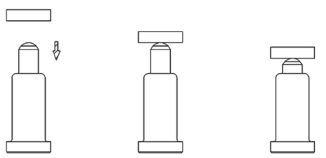
Oblique (diagonal)
For diagonal mating, set the contact angle to less than 15°. The mating cycle count is limited to 2,000 times.
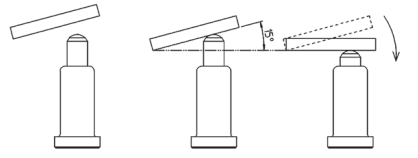
Sliding
If the mating process includes a sliding stroke, it may cause pin failure.Please consult with us in advance.

When inserting a mating terminal, push the terminal vertically.

Oblique (diagonal)
For diagonal mating, set the contact angle to less than 15°. The mating cycle count is limited to 2,000 times.

Sliding
If the mating process includes a sliding stroke, it may cause pin failure.Please consult with us in advance.

Is there any problem if SPRING CONNECTOR™ is placed on an angled mating terminal?
No. Please place the SPRING CONNECTOR™ within 5 degrees to the length axis of the product. If the angle exceeds 5°, please contact us.
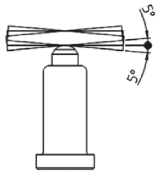

Are SPRING CONNECTOR™ suitable for a sliding mating method?
If you use SPRING CONNECTOR™ for a sliding mating, there is a possibility that the pin may be damaged.Please consult with us in advance.
How much should a SPRING CONNECTOR™ be compressed?
Please use within the recommended stroke range.
If you have any questions about the recommended stroke range, please contact us.
Recommended stroke
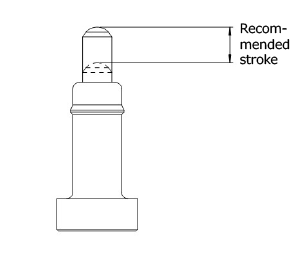
Recommended stroke range
Min. stroke:
Push in at least half of the stroke (L).
Max Stroke:
Reduce the the stroke length by 0.1mm(L-0.1mm ).
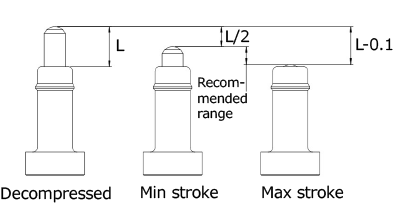
Caution: Max. Stroke
Deformation of the caulking part of the SPRING CONNECTOR™ due to over pressing may cause the pin to stuck, so please use within the recommended stroke range.
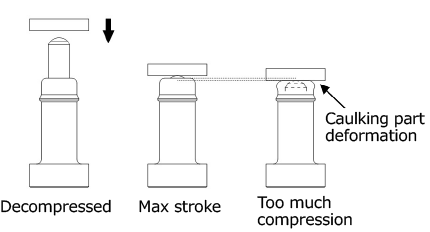
If you have any questions about the recommended stroke range, please contact us.
Recommended stroke

Recommended stroke range
Min. stroke:
Push in at least half of the stroke (L).
Max Stroke:
Reduce the the stroke length by 0.1mm(L-0.1mm ).

Caution: Max. Stroke
Deformation of the caulking part of the SPRING CONNECTOR™ due to over pressing may cause the pin to stuck, so please use within the recommended stroke range.

If SPRING CONNECTOR™ is used while compressed with a shorter stroke than the specified min. stroke, what are the risks involved?
There is a possibility that contact resistance becomes unstable, when compression length is too short.
Can SPRING CONNECTOR™ be used with live wire connection
and disconnection (hot swapping)?
Please refrain from using the SPRING CONNECTOR™ for live wire connection and disconnection. If needed, we would recommend 1) customer to add a protection circuit or 2) Connector with contact sequence by adding additional pins for grounding purpose. For detail, please contact our sales team.
Can the bottom of the SPRING CONNECTOR™ be used as a charging pad?
It is possible to use the bottom of the SPRING CONNECTOR™ tube as a charging pad. However, products from the standard catalogue range are not designed for this usage and specifications such as the cycle count cannot be guarantee If you intend to use the SPRING CONNECTOR™ in such a manner, please consult with us in advance.
Example of using the bottom of SPRING CONNECTOR™ as a charging pad
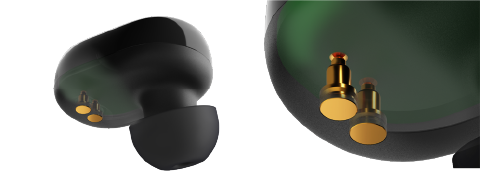
Example of using the bottom of SPRING CONNECTOR™ as a charging pad

What components can SPRING CONNECTOR™ be mounted on?
SPRING CONNECTOR™ can be mounted on PCBs and FPCs.
What are the precautions for mounting?
The standard mounting methods are reflow, flow, and hand soldering.
When mounting, please make sure that the suction cap attached to the product does not interfere with other components and that there are no other components that may deform the connector when a shock is applied.
When mounting, please make sure that the suction cap attached to the product does not interfere with other components and that there are no other components that may deform the connector when a shock is applied.
Is there a recommended land pattern?
Please provide the necessary areas for fillet formation to ensure solder
strength.
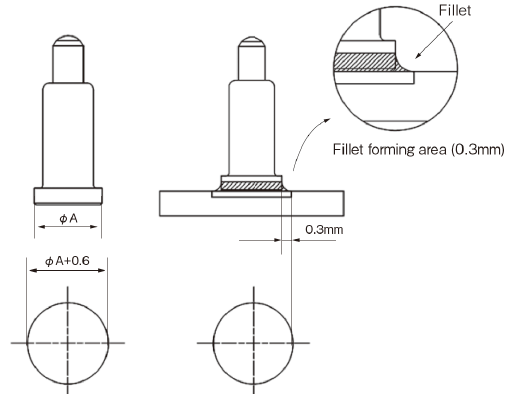
strength.

Is there a recommended metal mask thickness for surface mounting?
The thickness of the metal mask should be 0.1 mm or more considering the flatness of the terminal area of the product. (Terminal flatness of the product: Max 0.1 mm)
Can multiple single-pin type products be used side-by-side?
What precautions should I take when arranging them?
It is possible to use multiple single SPRING CONNECTOR™ side by side.
When defining the pin-to-pin pitch, please make sure that the suction caps attached to the products do not interfere with each other.
When defining the pin-to-pin pitch, please make sure that the suction caps attached to the products do not interfere with each other.
What is the plastic part on the SPRING CONNECTOR™?
The caps are attached to the products for automatic mounting in order for the mounting machine to pick up the product.The cap itself should be removed and disposed of after mounting. Whether or not the product can be adsorbed depends on the capabilities of the mounting service provider and the equipment.
Product in carrier tape
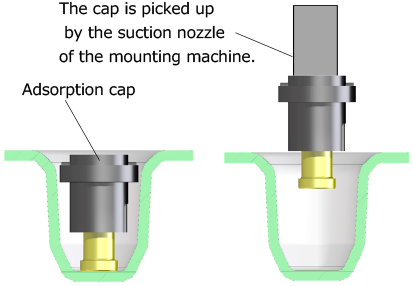
Product after mounting on board
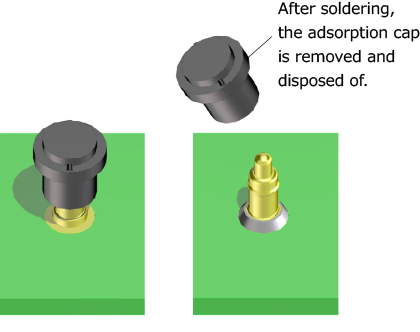
Product in carrier tape

Product after mounting on board

For low-profile SPRING CONNECTOR™, where is the suction area for automated mounting?
For low-profile SPRING CONNECTOR™, the suction area on the tube's upper surface should be used for mounting. For the shape of the suction nozzle, check with the mounting service provider to ensure that it does not interfere with the pin (moving part).
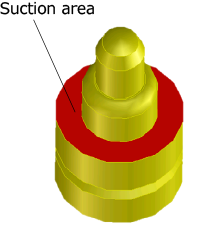

Are SPRING CONNECTOR™ compatible with N2 reflow?
There is no problem with N2 reflow mounting, as we have a proven track record.
Is it possible to solder a wire directly to a SPRING CONNECTOR™?
Yes, it is possible to solder a cable or wire directly to the bottom of the SPRING CONNECTOR™ tube. There is also an option to use a solder cup shaped tube for wire termination.
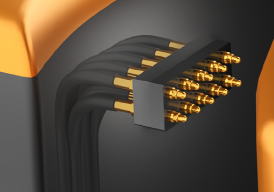

Is there any problem if foreign matter or water enters the tube of the SPRING CONNECTOR™?
Foreign matter or water intrusion into the tube may cause corrosion and malfunction.
For ingress protection, please consider the waterproof type available in our lineup.
For ingress protection, please consider the waterproof type available in our lineup.
Is it OK to wipe off the contacts when they get dirty?
Please wipe off the contacts with a soft cloth to avoid damaging the contacts.
After wiping, make sure there is no lint or other foreign matter attached to the contacts.
After wiping, make sure there is no lint or other foreign matter attached to the contacts.
I hear a creaking sound when compressing the SPRING CONNECTOR™. Is it defective?
There may be individual differences in the sound of the SPRING CONNECTOR™ during operation, but the creaking sound itself does not indicate any performance problems.
